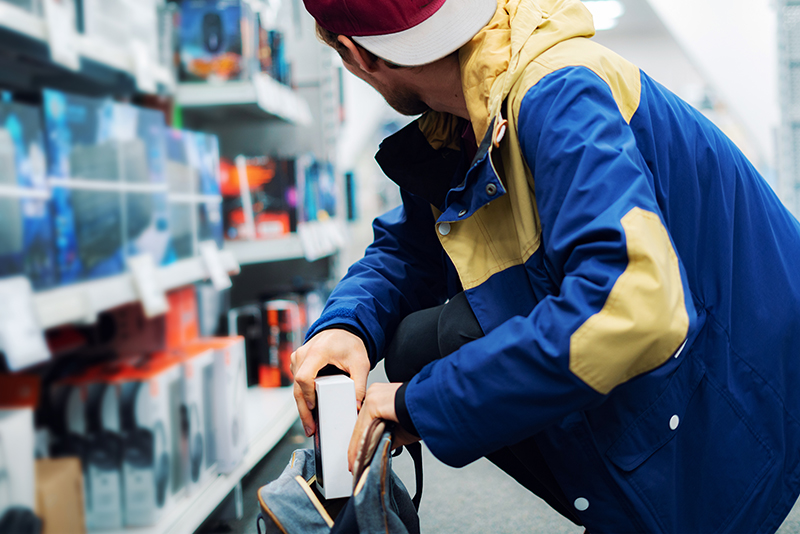The theory goes that the cost-of-living crisis and poor police responses are driving a crime wave. Is that really true?
According to media reports, in 2023 the UK experienced an unprecedented wave of shoplifting. The theory goes that the cost-of-living crisis and poor police responses are driving a crime wave.
Is that really true? Here, we assess six of the most popular assertions made about shoplifting in 2023. Are they myth or reality?
- Is there really a shoplifting epidemic?
Shoplifting has increased – but much of this reflects the fact that it declined 60% in the pandemic. So reports of year-on-year changes are misleading.
Many crime types remain below pre-pandemic levels because we now work from home more than we used to. But by 2023 we were out shopping as much as before. That provided camouflage for shoplifting, so it returned to, and now exceeds, pre-pandemic levels.
In the first six months of 2023, shoplifting reported to police averaged 7% above the pre-pandemic expected level. It then increased to 20% above the expected level in the summer months.
While most shoplifting is not reported to police, the available data suggests that the increase is not as dramatic as some accounts suggest.
Myth or reality? Half-myth. To some extent it remains to be determined with better data – but there is a problem.
- Has the cost-of-living crisis driven people to theft?
When department stores like John Lewis decry theft of their high-end products, this is not a cost-of-living issue – it implies organised gangs are operating for profit.
It has become common to blame the cost-of-living crisis for rises in shoplifting. However, several facts do not fit with this theory. Shoplifting by dependent drug users, for example, is not due to the cost-of-living crisis.
Likewise, when department stores like John Lewis decry theft of their high-end products, this is not a cost-of-living issue – it implies organised gangs are operating for profit. That explanation, put forward by the retailers themselves, contradicts the idea that increased shoplifting is due to cost-of-living issues.
Myth or reality? Myth and half-truth.
- Are organised gangs to blame?
Another version of events is more plausible – that organised gangs are the problem. The pandemic boosted online shopping, which made e-fencing of stolen goods easier, which in turn drives shoplifting. E-fencing via online marketplaces is more efficient and less risky than face-to-face in the street or pub.
The result is that some gangs now steal to order. A recent estimate suggests stolen and counterfeit goods account for 10% of online marketplaces.
Meanwhile, as the retail sector expanded, tempting new products are becoming readily available in large and anonymous self-service shops. Increases in mini-supermarkets means valuable items are closer to the door with fewer staff between the thief and the exit.
In the long term, then, it is change in the retail sector that inadvertently encourages shoplifting. We need more evidence, but organised crime offers a plausible explanation for increased post-pandemic shoplifting.
Myth or reality? Likely reality.
- Have the police stopped caring?
Like emitting pollution, creating shoplifting opportunities is effectively optional. Pointing the finger at the police deflects some of the blame but it doesn’t address the real problem.
The truth is, police have not been required to attend low-value shoplifting offences for many years. This reflects a long history of problem shops draining police resources with repeat calls without taking responsibility for preventing thefts.
After all, is it fair to expect taxpayers, who pay for police, to foot the bill? Or should retailers take responsibility for shoplifting just as other businesses are increasingly required to take responsibility for carbon emissions?
Like emitting pollution, creating shoplifting opportunities is effectively optional. Pointing the finger at the police deflects some of the blame but it doesn’t address the real problem.
Myth or reality? Myth.
- Are shops starting to lock up products because of theft increases?
In 2023 it was claimed that more items such as cheese, meat and coffee are being locked away or tagged. The truth is that these have been among the most stolen products for many years, and tagging has been around for ages.
It is part of a decades-long process of incremental improvements to retail security. By 2010, research identified 30 measures used to help shops prevent theft, including locking cabinets and adding radio frequency tagging to goods, tethering items or using dummy goods such as packaging with nothing in it.
It takes time, but security measures can evolve to be elegant and unobtrusive. Examples already exist – think of wide aisles with clear sight lines and clever packaging designs that make items difficult to conceal.
When someone meets you and greets you at the door, it’s not just to make shopping pleasant. It shows somebody cares and is watching. The development cycle of security means it sometimes begins as clunky and awkward before becoming something better.
Improved vehicle and household security reduced car crime and burglary by three-quarters since 1992, largely via non-punitive and unobtrusive measures. A suite of invisible car security is now triggered by a key fob, for example, and the best household security is built in as integrated locks on good quality doors.
These measures explain why there are fewer young people entering the criminal justice system. What’s more, shoppers are generally respectful of measures to reduce crime and promote safety even when they incur a minor inconvenience, such as tag removal at checkout. Overall, the history of security suggests we should be optimistic.
Myth or reality? Myth.
- Are social media provocateurs to blame?
Social media videos that glorify shoplifting and show how to do it may be part of the picture. Word of mouth took years to spread information that now spreads globally in seconds.
Social media videos that glorify shoplifting and show how to do it may be part of the picture. Word of mouth took years to spread information that now spreads globally in seconds.
A spate of thefts of Kia’s and Hyundai cars in the US is attributed to a viral TikTok explainer video and was stemmed only when the vehicle manufacturers issued a software update. Flash mobs have been co-ordinated on social media, as when hundreds of youths met to rob London’s Oxford Street stores.
Social media platforms are best placed and have the technical know-how to develop measures to stop videos from spreading and to make them less attractive to make and watch. It is not easy, but the evidence suggests that “offenders” will not just circumvent bans on illegal videos.
Myth or reality? Reality, but we need information about its impact.
What is to be done?
We need better information about the shoplifting problem. But we know that, with concerted effort, it is possible to prevent shoplifting.
Crime is always concentrated, so prevention efforts should be focused on the small proportion of shops that disproportionately experience shoplifting and the small number of hot products that are popular among thieves.
Online eCommerce platforms are best placed to prevent e-fencing, and social media platforms best placed to disrupt provocateurs. The appropriate role for government is to encourage these private sector agents into action through incentives (such as tax breaks for security) and disincentives (such as threat of regulation and fines).
This article first appeared on The Conversation, and is republished and a Creative Commons Licence; the original can be read here
About the Authors
 Graham Farrell is Professor of Crime Science at the University of Leeds, having previously been a professor at universities in Canada (Simon Fraser) the US (Rutgers, Cincinnati), and Loughborough University, and deputy research director at the Police Foundation, Washington DC. His earlier career included working as an international civil servant at the UN in Vienna, Research Associate at the Centre for Criminological Research at Oxford University, and research assistant at the Home Office Crime Prevention Unit. Graham’s research interests are in crime science, particularly situational crime prevention, with a particular focus in recent years on the international crime drop.
Graham Farrell is Professor of Crime Science at the University of Leeds, having previously been a professor at universities in Canada (Simon Fraser) the US (Rutgers, Cincinnati), and Loughborough University, and deputy research director at the Police Foundation, Washington DC. His earlier career included working as an international civil servant at the UN in Vienna, Research Associate at the Centre for Criminological Research at Oxford University, and research assistant at the Home Office Crime Prevention Unit. Graham’s research interests are in crime science, particularly situational crime prevention, with a particular focus in recent years on the international crime drop.
 Rachel Armitage is a Professor of Criminology within the School of Human and Health Sciences at the University of Huddersfield, and founded the multi-disciplinary Secure Societies Institute (SSI), which she directed between 2014 and 2018. Her research focuses upon the role of design (place, space, products and systems) in influencing both anti-social and pro-social behaviour, and she has conducted research on the subject of crime prevention through environmental design (CPTED) for over 20 years. Rachel also works closely with many agencies to explore the impact of secondary victimisation of online child sexual abuse – particularly indecent images of children.
Rachel Armitage is a Professor of Criminology within the School of Human and Health Sciences at the University of Huddersfield, and founded the multi-disciplinary Secure Societies Institute (SSI), which she directed between 2014 and 2018. Her research focuses upon the role of design (place, space, products and systems) in influencing both anti-social and pro-social behaviour, and she has conducted research on the subject of crime prevention through environmental design (CPTED) for over 20 years. Rachel also works closely with many agencies to explore the impact of secondary victimisation of online child sexual abuse – particularly indecent images of children.
Picture © Mike_shots / Shutterstock


